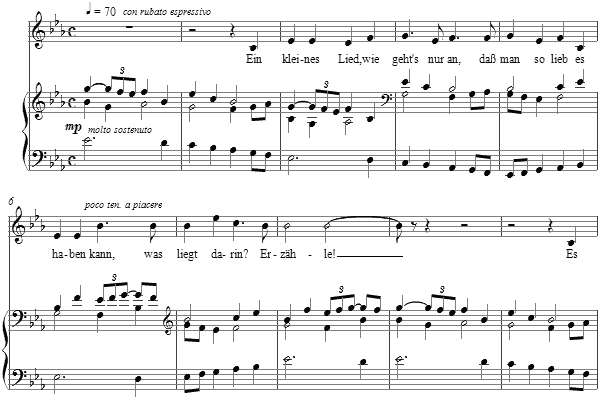Music and Texts of GARY BACHLUND
Vocal Music | Piano | Organ | Chamber Music | Orchestral | Articles and Commentary | Poems and Stories | Miscellany | FAQs
Ein kleines Lied - (2009)
Marie von Ebner-Eschenbach
for medium voice and piano
Ein kleines Lied, wie geht's nur an,
Daß man so lieb es haben kann,
Was liegt darin? Erzähle!
Es liegt darin ein wenig Klang,
Ein wenig Wohllaut und Gesang
Und eine ganze Seele.[ 1 page, circa 1' 15" ]
Marie von Ebner-Eschenbach
A little song, how does it take shape,
that one can love it so well?
Of what is it made? Say!
It is made of some sound,
some pleasing sound and singing
and all of the feeling of one's soul.
Marie von Ebner-Eschenbach (1830-1916) remains perhaps as Austria's best known female author. Noted for her psychological novels, she is regarded together with Ferdinand von Saar as among the most important German-language writers of the late 19th century. She was born to minor royalty as Countess Dubsky in Moravia, and began writing in her childhood, an disapproved activity for a nobility. Her best known works take as their subjects provincial Moravia and the urban life of the petit bourgeoisie and minor noble classes in Vienna.
She wrote detailed accounts of the daily routines of the "little man and woman." The plots are often based on the author's memories of her youth. Her story anthology, Dorf- und Schlossgeschichten (1883), included tales of provincial Moravia. She concluded that her own noble class was at fault for the poverty of the peasant farmers. She described social injustice, but she focused on the goodness that could be found in representatives of every social class, and believed that inherent human goodness would eventually overcome adversity. Her historical plays were less successful than her realistic novels and short stories. Her works won general acclaim only after 1874 and the changes in national politics which had earlier banned her work.
In 1900 she was awarded an honorary doctorate from the University of Vienna, the first to be awarded a woman, and died, during World War I, a respected member of Austria's literary elite.
She is credited with some wise aphorisms which stand well the test of time, among them: "Those who understand only what can be explained understand very little." And also: "To be content with little is hard; to be content with much, impossible."
The structure of the setting reflects the essential break in the rhyme scheme, a-a-b-c-c-b, such that the underlying accompaniment is a palindrome of sorts, in two repetitions. It drops from the higher tessitura to the exact next two measures an octave lower and then rises by the same kind of repetition ending at measure 8, and beginning again thereafter. A small coda adds the title of the poem as its last line.
The score for Ein kleines Lied is available as a free PDF download, though any major commercial performance or recording of the work is prohibited without prior arrangement with the composer. Click on the graphic below for this piano-vocal score.

